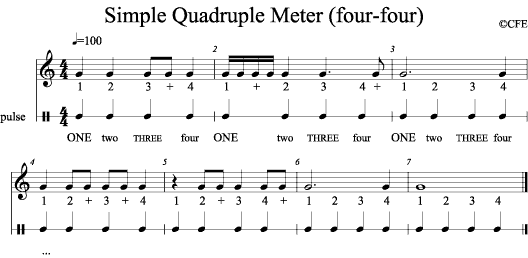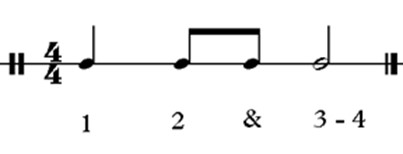
The Key Characteristics of West and Central African Music 2
In the African Drumming From 1930 video from 02.00 - 02.18, you can hear a rhythmic variant placed within the basic pulse. It is important to note that this particular variant contains 2.5 beats that the performer can shift to start at any beat at will. The following example illustrates that the first pattern entry falls on measure one's downbeat, and the duplet falls on beat two. In contrast, the second entry falls on the fourth beat of the measure, and the duplet falls on the downbeat of the following measure, i.e., measure two.

African Drumming From 1930 [ 02:00-02:18 ]

Continuous Pulse Rhythmic Variant
A.M. Jones states: "Rhythm is to the African what harmony is to the Europeans, and it is in the complex interweaving of contrasting rhythmic patterns that he finds his greatest aesthetic" (1993, 26).
We can refer to rhythm as the interplay of sound and silence in time, where both elements-sound and silence-are equally important. As we attempt to dissect the union of rhythm, dance, and song, we will define rhythmThe division of music into regular metric portions; the regular pulsation of music. as the organization of sound in time, i.e., groupings of sound and silence organized around a given parameter. In the European notated tradition, this parameter is known as a time signature.A symbol placed at the left side of the staff indicating the meter of the composition. For example, a time signature of 3/4 would indicate that there are three quarter notes in each measure and the quarter notes receive the main pulse (or beat). In a time signature, the top number indicates how many beats (pulses) are contained in each measure, and the bottom number indicates the note value that corresponds to each of those beats.
In the following example, the top number four indicates that there are four beats in each measure, and the bottom number four indicates that each beat is equivalent to a quarter note. The example shows a straight four-four measure pulse in quarter notes. Notice that in the first bar, the third quarter note is subdivided into two eighth notes. We could also combine two quarter notes into one half note or four quarter notes into one whole note.

Simple Quadruple Meter - Pulse
Additionally, in the example below, each beat is worth one of the four quarter notes that are contained in a measure. This example also shows how a collection of note values or "sounds" are "organized" in a measure. Notice on beat two, there are two notes (in this case eighth notes), so you will hear two "sounds" (two &) within that second beat. The second eighth note is heard on the (&) of beat two.

Note Values in a Measure
This is what musicians would refer to as the upbeatThe last beat of any measure, usually a weak beat. The conductor always directs it with an upward swing of the baton or hand, anticipating the first beat of the next measure.. Essentially, the quarter note has been divided into two equal halves. The opposite occurs on the downbeatThe first beat of the measure. When played under the direction of a conductor, it is signified by the downward movement of the conductor's hand. of three. Now, the unit of the beat has been lengthened twice its value. Therefore, beats three and four consist of one sound that is heard for two beats (units). As long as there are no variations or configurations that would disturb the natural flow of an established tempoThe speed of the beat or pulse. , this is considered a basic rhythm pattern. However, it is precisely these disturbances that make Western and Central African music incredibly intriguing. The example given shows a divisive rhythm pattern added to the basic pulse. Notice that each sound occurs between the beats, not on the beat. Herein lies a key ingredient in the concept of African rhythm, song, and dance.

Divisive Rhythm Pattern
Ayantoyese Onifade
A society without drum is engrossed in bitterness.
A.M. Jones
Rhythm is to the African what harmony is to the Europeans, and it is in the complex interweaving of contrasting rhythmic patterns that he finds his greatest aesthetic.








